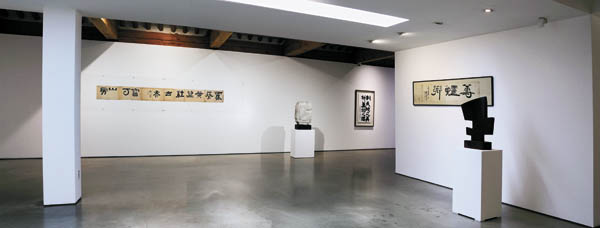Drawing lines that connect old and new

The “Chusa Kim Jeong-hui and Woosung Kim Chong Yung” exhibition will show the works of Joseon-era seoye (calligraphy) master Chusa alongside those of the pioneer of modern Korean abstract sculpture. Kim Chong Yung was inspired by Chusa. The show starts at the Hakgojae Gallery on Friday. Provided by the gallery
One of them is “Dream Society Season 3,” which kicked off Saturday at the Seoul Museum in Buam-dong, central Seoul. As part of Hyundai Motor’s art patronage project, the annual multidisciplinary exhibition has featured hot contemporary artists, designers, architects and engineers. But this year’s edition starts with one of Chusa’s seoye pieces, while the other exhibits are by contemporary artists and designers.
“This year’s theme is originabilty, a word coined by combining originality and ability,” Min Byungjic, curator of the exhibition, told the Korea JoongAng Daily at the opening. He is vice director of the Alternative Space Loop gallery.
“That’s what Korean artists in the global art scene now seek intensely,” he continued. “Chusa is a paragon of originability.”

Paintings by contemporary seoye master and scholar Kim Jongweon, left, and installation works by Lee Seung-taek, which are reminiscent of seoye strokes, are part of the “Dream Society Season 3” exhibition at the Seoul Museum, which pays homage to Chusa’s originality. By Moon So-young
Chusa’s seoye piece in the “Dream Society” exhibition leads to installation works by Lee Seung-taek, who, while in his early 80s, has begun receiving international attention in the past few years. Many of his works are reminiscent of seoye brush strokes.
The works by the 10 contemporary artists and designers participating in the show are diverse in media, themes and visual impressions.
Among the exhibits are paintings by contemporary seoye master and scholar Kim Jongweon. The paintings, filled with vermilion-colored characters he created based on ancient Chinese characters and grotesque images, can be associated with the imagery of old Asian talismans.
“Kim’s works show the quality of seoye as abstract art,” Min explained. “Like seoye, in his paintings, images and text are not separate things.”
There was also an artist who early recognized the quality of abstract art in seoye, in particular Chusa-che. He was Kim Chong Yung (1915-82), one of the most important modern Korean sculptors and a pioneer of Korean abstract sculpture.
Another exhibition, titled “Chusa Kim Jeong-hui and Woosung Kim Chong Yung,” will show Chusa’s seoye pieces alongside Kim’s sculptures. It starts on Friday at the Hakgojae Gallery in Jongno District, central Seoul.
“This exhibition will show Hakgojae’s philosophy of ‘to review the old to learn the new,’ which was also that of Chusa,” Woo Chan-kyu, director of the gallery, said at a press preview last week.
“The sculptor was greatly inspired by Chusa,” said Park Choon-ho, chief curator of the Kim Chong Yung Museum, which helped arrange the exhibition.
“Kim focused on the architectural qualities of Chusa-che and compared it to paintings by Paul Cezanne [the French Post-Impressionist artist]” Park said.
BY MOON SO-YOUNG [symoon@joongang.co.kr]
The Seoul Museum exhibition runs until Oct. 11. Admission is 5,000 won ($4.18) for adults. The museum is closed on Mondays. Take bus Nos. 1020, 1711, 7016, 7018, 7022 or 7212 to the Jahamun Tunnel stop. For details, visit www.seoulmuseum.org or call (02) 395-0100.
The Hakgojae show runs through Oct. 14. Admission is free. The gallery is closed on Mondays. Go to Anguk Station, line No. 3, exit 1, and walk for 10 minutes. For details, visit www.hakgojae.com or call (02) 720-1524.










with the Korea JoongAng Daily
To write comments, please log in to one of the accounts.
Standards Board Policy (0/250자)